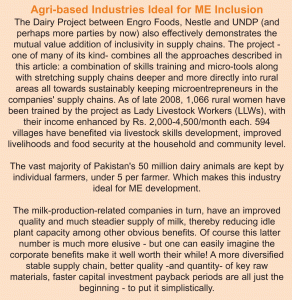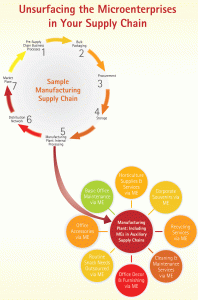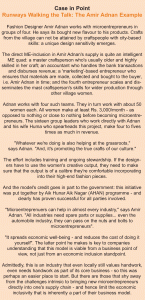Economic inclusivity is arguably the fundamental consideration in the ‘profits’ bottom-line (assuming that transparency, legal compliance, tax obligations and all such matters are well in-line). Inclusivity, both at the international and macro-economic level is what has the ability to truly contextualize the economic behaviour of an entity. For instance, at the international level, we have issues such as repatriation versus local investment of MNCs. At the wider economic level, we consider the localization of supply chains to ensure local communities’ inclusion in business’s economic impact circles.
Inclusivity in the CSR Space
Our very own Federation of Pakistan Chambers of Commerce and Industry defines CSR for itself, at the macro-level representation of private sector, as “…the strategic and practical link between inclusive development and economic growth…”.
One facet of economic activity that is perhaps not being harnessed to its true potential is the economic value of microenter-prises in supply chains.
We’ve all heard about the provision of micro solutions towards economic inclusivity, in the form of micro credit, microenterprise, micro financial instruments and so on.
But the idea of companies playing a direct role in facilitating the germination of microenterprises remains a little understated. And, implementation at the micro and macro levels still significantly underestimated and under invested.
Traditionally microenterprises are defined, particularly for policy-making purposes, as those that employ less than 10 people. However, in the context of this article and deeper economic inclusivity, the ME focus is more on single person or single family livelihood sources. MEs are owned and operated by poorer people and are usually in the informal sector. What is key is that MEs are a route to de-marginalising the working poor, particularly where issues of feudalism further stifle access. Universally, there is no authori-tative definition of MEs. And,definitions are certainly relative: the EU defines MEs as those enterprises with a turnover or balance sheet total under 2 million. If only we could define them the same way in Pakistan!
The capital investment required to get an ME off the ground is usually quite low, frequently well under Rs. 10,000 – this threshold in itself is the removal of an access barrier. Microentrepre-neurs are often produce vendors, non motorized vehicle operators-drivers, barbers, village phones and/or PCOs, farmers, fishermen, tailors, waste recycles, women’s beauty service providers among numerous others. You’ll notice MEs are not barred by the rural-urban divide and are prevalent across the board. Such enterprises have positive ripple effects, on living standards as well as economic access for the poor and are integ-ral to national economic growth (albeit they’re seen as marginal).
The ME-Happy Supply Chain
In an agri-based economy like Pakistan’s, microenterprises (MEs) are likely to be ‘invisibly’ suppor-ting any given company’s supply chain, be it a textile manufacturer or food company. 70 percent of Pakistan’s population remains dependant on land and livestock for its survival.
Visualize your industry’s supply chain. Or any supply chain: to facilitate MEs in your business’ supply chain, all you need to really do with an open mind and heart is:
- Break down and picture your supply chain.
- Stop and study each step in it.
- Analyze the nodes to see where in your supply chain you can include services/ products from microenterprises.
- Create mechanisms to interact with MEs, consult with sub-sector specialists and go for it!
Voila! Your supply chain is speci-fically geared towards economic inclusivity. By gently scratching the surface of our supply chains, we can learn so much about our economic cycles.
Sins of Supply Chain Complacency
In a developing country like Pakistan, the direct-indirect disconnect is a wide abyss. Direct inclusivity in supply chains could translate into a microentrepreneur actually prospering via direct contact with valueadded economic growth. Otherwise, these microentrepreneurs are
likely to be robbed of their fair wages and growth opportunities by middlemen who hoard the benefit by liasing with global or local supply chains. This direct inclusivity concept is what drives models akin to fair trade.
Of course this is a simplistic way of looking at the role of middlemen, because there are complex dynamics that keep each party in an economic transaction in place. There is some ‘value’, or role, that each party offers or plays – which keeps the links in the chain moving. Middlemen cannot be eliminated. Banks are, for instance, after all, akin to middlemen given the services they provide. The point is simply that companies can establish direct support and communication links throughout their value chains. With microenterprises, for instance, they can provide skills training, microfinance.

To be sustainable and responsible citizens, companies must look beyond traditional supply chain mechanisms to explore how they can include more people, fairly, into their supply chains: a better world is possible.
Complacency seems a rather unforgivable sin for intelligent beings. That includes supply chain complacency: not digging deeper, turning a halfblind eye to what keeps our businesses going and so on.

Keeping it Sustainable: Management
The goal of all this microenterprise (ME) business is obviously to include lesser-privileged groups into economic activity. These groups, explicably, tend to have limited access to education and information. So it makes direct business sense to support those who will in turn support one’s own business – and if their economic inclusion itself is to be sustainable.
Many BoP (bottom of the -socio-economic- pyramid) businesses or venture capitalists have found that creating microentrepreneurs at the BoP is just the first step. Without relevant managerial skills and financial savvy suppor-ting the microentrepreneur, their business is likely to fail.
So the key to setting an ME up for success is to fill such support gaps for microentrepreneurs.
For instance, sharing primitive financial planning with the ME even at a truly basic simple mathematical level can be not only deeply empowering, but ensure the ME’s ability to manage their simple assets and cash flows in a way that doesn’t negatively impact the business or personal needs. This will also provide the foundation for the ME to be able to scale her/his microenterprise when that opportunity presents itself.
& Micro-Tools
Companies will need to offer -or partner with those who offer various microenterprise support instruments and services to make this entire effort sustainable. For microentrepreneurs to be able to offer the quality of goods or servi-ces that meet the purchasing standards of companies, they will inevitably need to upgrade either their skill sets, equipment/tools or both. And for this, the medium of money must unfortunately be tapped into.
May 2009, the World Bank released its report “Bringing Finance to Pakistan’s Poor: A Study on Access to Finance for the Underserved and Small Enter-prises,” re-affirming the corelation between financial access and economic inclusivity.
There are significant hurdles to be crossed before financial inclusion is a reality in Pakistan right now only 14 percent of Pakistani adults use financial products or services from financial institutions. Over half of the population saves, but only 8 percent entrust their money to formal financial institutions; they save at home and borrow from family or friends in cases of dire need.
The report concludes that major constraints to financial access arise from high levels of poverty, low awareness of available financial services, and gender bias.
“If appropriately supported, SMEs have the potential to be the growth engine of the economy due to their ability to create jobs, foster entrepreneurship, and to provide depth to the industrial base of the economy,” says Tatiana Nenova, World Bank Senior Economist and lead author of the report. “However, SMEs get a disproportionately small share of credit relative to their economic importance. In fact, SME lending accounts for only 16 percent of total lending volume. Aggressive promotion of an enabling environment for SME lending is vital to reverse this trend.”
If SMEs receive such disproportionate priority, MEs seem to not even be on the economic policy agenda’s totem pole. There was ofcourse the President’s Rozgar scheme several years which put together several of the micro-links thereby directly creating microentrepreneurs.
It obviously follows then, that Pakistan’s microfinance sector has considerable growth potential: the formal microfinance sector reaches less than 2 percent of the poor, as opposed to over a quarter in Bangladesh, India, or Sri Lanka – according to the World Bank.
MEs in Auxiliary Supply Chains
Also, it is even easier to include microentrepreneurs in ones ‘auxiliary’ supply chains – that means supply chains that a company must tap into, but that are not a part of its core business. For instance, MEs can provide various offices supplies. They can also provide services on a regular basis such as catering and event management or sporadically such as landscaping and pest control.
Since microentrepreneurs are often highly skilled with their hands handwork is something highly valued in various parts of the developed world, MEs can also be sought to provide corporate souvenirs. This better leverages authentic local flavours from Pakistan’s indigenous arts and craft. And, often has a reduced environmental impact given the non-mechanized nature of MEs.
It is, however, important to meaningfully support MEs in order to make them long-term partners for mutual business growth. For instance, by working with the ME¸for products that suit the buyer’s own aesthetics, the microentrepreneurs is also creating direct market knowledge (and of course access!) for craftspeople who otherwise may have no idea of what really sells. This enhances the ME’s profit margins. And in the long term also facilitates BoP businesses in improving their managerial and marketing skills, enabling them to improve their credit worth and economic viability.

The case in point ‘Runways Walking the Talk’ illustrates that all business operations need to see where in their supply chain room can be created for developing and involving MEs, on a mutual benefit basis. The MEs offer business saving in terms of the company not having to create the infrastructure itself for undertaking support tasks that do not add value as such but which are required as support operations.
It’s all about Access!
The direct inclusion of MEs into business supply chains and the subsequent support to make them sustainable is the kind of driver that will sustain meaningful economic growth in developing countries like Pakistan. Linking the beginning of the supply chain, for example, the farmer, with the end of the supply chain, for example, the general public, is what makes the fair trade model spin: Direct relationships between the producer and the consumer. And it is what has the inherent ability to reduce skewed capitalistic economic growth but not without proper training for the potential micro-entrepreneurs.
If rice cultivators in southern Punjab and chilli growers in Kunri can have easies access to fair microfinance opportunities and direct access to markets,middlemen would in a position to leverage unfair gains by exploiting the absence of this very link. The nation’s most vulnerable BoP suppliers, farmers, wouldn’t be so vulnerable anymore, with the kind of informational intelligence that direct access brings with it.






Valuable thoughts and advices. I read your topic with great interest.
I liked it. So much useful material. I read with great interest.
good info keep it coming
In truth, immediately i didn’t understand the essence. But after re-reading all at once became clear.
I read a few topics. I respect your work and added blog to favorites.
Hello. Thank you. We much appreciate your interest in tbl and look forward to your comments.